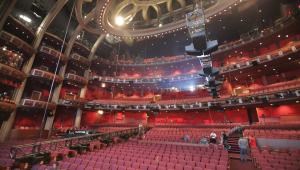Behind The Numbers: Digital Surround Receivers Page 3
Since the AC line voltage can influence power measurements, and it tends to dip by several volts as the maximum output from a high-power amplifier is reached, we monitor the line voltage to the receiver during these tests to prevent the equivalent of a brownout. Using a variac (a large, variable, line-voltage transformer), we adjust the line voltage manually so that it stays within 1% of 120 volts (118.8 to 121.2 volts rms) when the receiver's maximum output is reached.
In our stereo maximum output tests, we drive both channels (left/right front) simultaneously with the receiver switched to stereo operation. Some receivers internally rewire their power-supply circuits for multichannel operation, so testing only the front L/R channels while the receiver is switched for full 5.1-channel operation can give lower results than in true stereo operation. For our 1-channel Dolby Digital power test, we use the center (front) channel, as that is the one usually driven hardest in a multichannel soundtrack mix.
In our tests with five or six channels playing our reference-level (-20-dBFS) signal, we take special pains - using the receiver's channel-balance controls - to make sure that the output from every channel is as close to 1 watt as possible. Imbalances here, such as when some channels are 3 dB below the others, can considerably relieve the receiver's burden at full output. If any imbalances remain, we monitor the odd-man-out channel - the one that's slightly higher than the rest - as it will be the first to overload. These all-channels tests are tough, and it's not unusual to see large differences between our results and a receiver's wattage specs (which are usually not made with all channels driven).
Over the years we've also seen some receivers whose one-channel and all-channels power tests gave dramatically different results, like 100 watts and "only" 40 watts, respectively. Here is another case where the dBW unit clarifies things. Our examples are equivalent to 20 and 16 dBW, respectively, a 4-dBW difference that would be audible and significant taken on its own. But add those dBW figures to a typical speaker sensitivity rating of 90 dB, and you get respective 1-meter SPLs of 110 dB with one channel driven and 106 dB per speaker with all channels driven.
Since even one speaker playing at 106 dB SPL would be quite loud, much less all five of them at once, it's clear that our example's startling 60-watt difference in power levels, or even the 4-dBW difference, is less significant in actual listening conditions - you might never turn the receiver's volume control high enough to run out of juice! On the other hand, if the difference between the one-channel and all-channels tests is large (more than 5 dBW, say) and the overall levels in dBW are low with all channels driven (around 15 dBW, say, or lower), you may have trouble getting distortion-free reproduction of movie soundtracks at satisfyingly loud volumes. (Note that our procedures are optimized for receivers whose front and surround channels all have the same power rating, which is typical though not universal.)
Bass Management One of the most important tasks a multichannel receiver is called on to perform is bass management, which has two parts: 1) using high-pass filters to remove deep-bass frequencies from the channels feeding any speakers that can't reproduce deep bass, and 2) mixing the extracted deep-bass information with the bass-only low-frequency-effects, or LFE, channel - if there is one in the recording - so the combination can be fed to the receiver's subwoofer output. (The LFE channel is the ".1" in a 5.1-channel system.)
To test a receiver's bass management, we take frequency-response measurements of the main-channel and subwoofer outputs when the receiver is set for operation with all "small" main speakers, which on many recent models is called "normal." The results, which show up in a graph like Figure 2, may help you choose a receiver whose bass-management system is the best match for your speakers. Or, coming at it from the other direction, you may be able to choose speakers that best match the requirements of your receiver.
The most important requirement a receiver puts on a speaker system (or vice versa) stems from the crossover between the main speakers and the subwoofer. In most receivers the bass crossover frequency is fixed at 80 or 100 Hz (the latter is shown in Figure 2). In order to get a smooth blend, the main speakers used with any receiver we test should have reasonably flat response down to the crossover frequency cited in our test report. The higher the crossover frequency (say, 100 Hz and above), the easier it will be to match the receiver with home theater systems that have small "satellite" speakers. If the crossover frequency is 80 Hz or lower, the main speakers in the system should be largish satellites or small tower models that have decent-size woofers.
A bad match here - specifically, very small satellite speakers and a low crossover frequency - can create an audible gap in the important midbass frequency range between where the main speakers roll off and the subwoofer kicks in. Receivers with variable crossover frequencies are considerably more versatile in this respect than fixed-frequency models.




























































